I'm working in a project that need to show a NavigationView inside a fragment. It's working fine but consume a lot of battery (and depending of the device in some increase temperature considerably). I checked the profiler in AS to try to identify the issue,
let's see...
As I can understand, Mapbox Navigation ask for location in High Accuracy every one second. The question is, there is any way to configure the priority or the interval to reduce battery comsumption?
I followed the official docs to implement a custom LocationEngine, and works right for MapView, but not for NavigationView.
Anyone had this kind of issues in terms of performance with Mapbox Navigation? I've already test it in new and old devices and it's the same every time.
I'm using:
implementation "com.mapbox.navigation:ui:1.4.0"
implementation 'com.mapbox.mapboxsdk:mapbox-android-sdk:9.6.0'
And here are some part of my implementation,
private fun initLocationEngine() {
locationEngine = LocationEngineProvider.getBestLocationEngine(requireContext())
// i don't know if is necessary to remove location updates before configure a new location engine
locationEngine?.removeLocationUpdates(this)
val request =
LocationEngineRequest.Builder(30000)
.setPriority(LocationEngineRequest.PRIORITY_BALANCED_POWER_ACCURACY)
.setMaxWaitTime(10000).build()
locationEngine?.requestLocationUpdates(request, this, getMainLooper())
}
override fun onMapReady(mapboxMap: MapboxMap) {
mapView = mapboxMap
mapView.setStyle(Style.TRAFFIC_DAY) {
initLocationEngine()
initCamera(mapboxMap)
}
}
private fun setupNavigationOptions(directionsRoute: DirectionsRoute): NavigationViewOptions {
val options = NavigationViewOptions.builder(requireContext())
options.directionsRoute(directionsRoute)
.navigationListener(this)
.feedbackListener(this)
.locationObserver(this)
.locationEngine(locationEngine)
return options.build()
}
private fun getNavigationRoute(origin: Point, destination: Point) {
val navigation = MapboxNavigation.defaultNavigationOptionsBuilder(getCurrentContext(), Mapbox.getAccessToken())
mapboxNavigation = MapboxNavigation(navigation.build())
val routeOptions = RouteOptions.builder()
.applyDefaultParams()
.accessToken(Mapbox.getAccessToken()!!)
.coordinates(coordinates)
.geometries(RouteUrl.GEOMETRY_POLYLINE6)
.profile(DirectionsCriteria.PROFILE_DRIVING)
.alternatives(false)
.voiceUnits(DirectionsCriteria.METRIC)
.build()
mapboxNavigation.requestRoutes(routeOptions, object : RoutesRequestCallback {
override fun onRoutesReady(routes: List<DirectionsRoute>) {
if (routes.isNotEmpty() && isAdded) {
val currentRoute = routes.first()
navigationView.startNavigation(setupNavigationOptions(currentRoute))
showNavigationMode()
}
}
override fun onRoutesRequestFailure(throwable: Throwable, routeOptions: RouteOptions) {
Timber.e("route request failure %s", throwable.toString())
}
override fun onRoutesRequestCanceled(routeOptions: RouteOptions) {
Timber.d("route request canceled")
}
})
}
// these methods are from LocationObserver callback
override fun onEnhancedLocationChanged(enhancedLocation: Location, keyPoints: List<Location>) {
// this method called every second, so, LocationEngine it's configured fine but the criteria and interval configuration does'nt work
}
override fun onRawLocationChanged(rawLocation: Location) {
}
// EDIT After Yoshikage Ochi comment I made some changes to my setupNavigationOptions method:
private fun setupNavigationOptions(directionsRoute: DirectionsRoute): NavigationViewOptions {
val navViewOptions = NavigationViewOptions.builder(requireContext())
val navOpt = MapboxNavigation.defaultNavigationOptionsBuilder(requireContext(), Mapbox.getAccessToken())
val request =
LocationEngineRequest.Builder(30000)
.setPriority(LocationEngineRequest.PRIORITY_BALANCED_POWER_ACCURACY).build()
navOpt.locationEngineRequest(request)
navViewOptions.navigationOptions(navOpt.build())
navViewOptions.directionsRoute(directionsRoute)
.navigationListener(this)
.feedbackListener(this)
.locationObserver(this)
return options.build()
}
But unfortunatly it does'nt work. The period and the priority is the same (maybe the default), I've receiving updates every second and in HIGH_PRIORITY.
